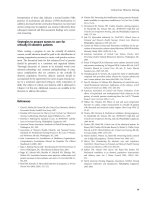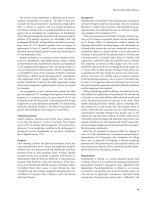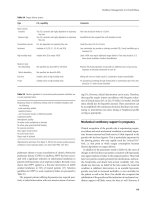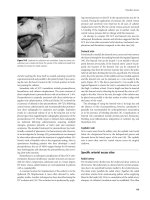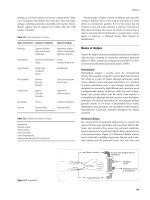Critical care medicine - part 10 pps
Bạn đang xem bản rút gọn của tài liệu. Xem và tải ngay bản đầy đủ của tài liệu tại đây (85.57 KB, 15 trang )
138 Hypermagnesemia
3. Agents that enhance renal magnesium excretion include alcohol,
loop and thiazide diuretics, amphotericin B, aminoglycosides, cisplatin,
and pentamidine.
D. Alterations in magnesium distribution
1. Redistribution of circulating magnesium occurs by extracellular to
intracellular shifts, sequestration, hungry bone syndrome, or by acute
administration of glucose, insulin, or amino acids.
2. Magnesium depletion can be caused by large quantities of parenteral
fluids and pancreatitis-induced sequestration of magnesium.
II. Clinical manifestations of hypomagnesemia
A. Neuromuscular findings may include positive Chvostek's and Trous-
seau's signs, tremors, myoclonic jerks, seizures, and coma.
B. Cardiovascular. Ventricular tachycardia, ventricular fibrillation, atrial
fibrillation, multifocal atrial tachycardia, ventricular ectopic beats, hyper-
tension, enhancement of digoxin-induced dysrhythmias, and cardio-
myopathies.
C. ECG changes include ventricular arrhythmias (extrasystoles, tachycardia)
and atrial arrhythmias (atrial fibrillation, supraventricular tachycardia,
torsades de Pointes). Prolonged PR and QT intervals, ST segment
depression, T-wave inversions, wide QRS complexes, and tall T-waves
may occur.
III. Clinical evaluation
A. Hypomagnesemia is diagnosed when the serum magnesium is less than
0.7-0.8 mmol/L. Symptoms of magnesium deficiency occur when the
serum magnesium concentration is less than 0.5 mmol/L. A 24-hour urine
collection for magnesium is the first step in the evaluation of
hypomagnesemia. Hypomagnesia caused by renal magnesium loss is
associated with magnesium excretion that exceeds 24 mg/day.
B. Low urinary magnesium excretion (<1 mmol/day), with concomitant serum
hypomagnesemia, suggests magnesium deficiency due to decreased
intake, nonrenal losses, or redistribution of magnesium.
IV. Treatment of hypomagnesemia
A. Asymptomatic magnesium deficiency
1. In hospitalized patients, the daily magnesium requirements can be
provided through either a balanced diet, as oral magnesium supple-
ments (0.36-0.46 mEq/kg/day), or 16-30 mEq/day in a parenteral
nutrition formulation.
2. Magnesium oxide is better absorbed and less likely to cause diarrhea
than magnesium sulfate. Magnesium oxide preparations include Mag-
Ox 400 (240 mg elemental magnesium per 400 mg tablet), Uro-Mag
(84 mg elemental magnesium per 400 mg tablet), and magnesium
chloride (Slo-Mag) 64 mg/tab, 1-2 tabs bid.
B. Symptomatic magnesium deficiency
1. Serum magnesium
#0.5 mmol/L requires IV magnesium repletion with
electrocardiographic and respiratory monitoring.
2. Magnesium sulfate 1-6 gm in 500 mL of D5W can be infused IV at 1
gm/hr. An additional 6-9 gm of MgSO
4
should be given by continuous
infusion over the next 24 hours.
Hypermagnesemia 139
Hypermagnesemia
Serum magnesium has a normal range of 0.8-1.2 mmol/L. Magnesium
homeostasis is regulated by renal and gastrointestinal mechanisms.
Hypermagnesemia is usually iatrogenic and is frequently seen in conjunction with
renal insufficiency.
I. Clinical evaluation of hypermagnesemia
A. Causes of hypermagnesemia
1. Renal. Creatinine clearance <30 mL/minute.
2. Nonrenal. Excessive use of magnesium cathartics, especially with
renal failure; iatrogenic overtreatment with magnesium sulfate.
B. Cardiovascular manifestations of hypermagnesemia
1. Hypermagnesemia <10 mEq/L. Delayed interventricular conduction,
first-degree heart block, prolongation of the Q-T interval.
2. Levels greater than 10 mEq/L. Low-grade heart block progressing
to complete heart block and asystole occurs at levels greater than
12.5 mmol/L (>6.25 mmol/L).
C. Neuromuscular effects
1. Hyporeflexia occurs at a magnesium level >4 mEq/L (>2 mmol/L);
diminution of deep tendon reflexes is an early sign of magnesium
toxicity.
2. Respiratory depression due to respiratory muscle paralysis, somno-
lence and coma occur at levels >13 mEq/L (6.5 mmol/L).
3. Hypermagnesemia should always be considered when these
symptoms occur in patients with renal failure, in those receiving
therapeutic magnesium, and in laxative abuse.
II. Treatment of hypermagnesemia
A. Asymptomatic, hemodynamically stable patients. Moderate hyper-
magnesemia can be managed by elimination of intake.
B. Severe hypermagnesemia
1. Furosemide 20-40 mg IV q3-4h should be given as needed. Saline
diuresis should be initiated with 0.9% saline, infused at 120 cc/h to
replace urine loss.
2. If ECG abnormalities (peaked T waves, loss of P waves, or widened
QRS complexes) or if respiratory depression is present, IV calcium
gluconate should be given as 1-3 ampules (10% solution, 1 gm per 10
mL amp), added to saline infusate. Calcium gluconate can be infused
to reverse acute cardiovascular toxicity or respiratory failure as 15
mg/kg over a 4-hour period.
3. Parenteral insulin and glucose can be given to shift magnesium into
cells. Dialysis is necessary for patients who have severe
hypermagnesemia.
140 Disorders of Water and Sodium Balance
Disorders of Water and Sodium Balance
I. Pathophysiology of water and sodium balance
A. Volitional intake of water is regulated by thirst. Maintenance intake of
water is the amount of water sufficient to offset obligatory losses.
B. Maintenance water needs
= 100 mL/kg for first 10 kg of body weight
+ 50 mL/kg for next 10 kg
+ 20 mL/kg for weight greater than 20 kg
C. Clinical signs of hyponatremia. Confusion, agitation, lethargy, seizures,
and coma.
D. Pseudohyponatremia
1. Elevation of blood glucose may creates an osmotic gradient that pulls
water from cells into the extracellular fluid, diluting the extracellular
sodium. The contribution of hyperglycemia to hyponatremia can be
estimated using the following formula:
Expected change in serum sodium = (serum glucose - 100) x 0.016
2. Marked elevation of plasma lipids or protein can also result in
erroneous hyponatremia because of laboratory inaccuracy. The
percentage of plasma water can be estimated with the following
formula:
% plasma water = 100 - [0.01 x lipids (mg/dL)] - [0.73 x protein (g/dL)]
II. Diagnostic evaluation of hyponatremia
A. Pseudohyponatremia should be excluded by repeat testing. The cause of
the hyponatremia should be determined based on history, physical exam,
urine osmolality, serum osmolality, urine sodium and chloride. An
assessment of volume status should determine if the patient is volume
contracted, normal volume, or volume expanded.
B. Classification of hyponatremic patients based on urine osmolality
1. Low-urine osmolality (50-180 mOsm/L) indicates primary excessive
water intake (psychogenic water drinking).
2. High-urine osmolality (urine osmolality >serum osmolality)
a. High-urine sodium (>40 mEq/L) and volume contraction
indicates a renal source of sodium loss and fluid loss (excessive
diuretic use, salt-wasting nephropathy, Addison's disease, osmotic
diuresis).
b. High-urine sodium (>40 mEq/L) and normal volume is most
likely caused by water retention due to a drug effect,
hypothyroidism, or the syndrome of inappropriate antidiuretic
hormone secretion. In SIADH, the urine sodium level is usually
high. SIADH is found in the presence of a malignant tumor or a
disorder of the pulmonary or central nervous system.
c. Low-urine sodium (<20 mEq/L) and volume contraction, dry
mucous membranes, decreased skin turgor, and orthostatic
hypotension indicate an extrarenal source of fluid loss (gastrointes-
tinal disease, burns).
d. Low-urine sodium (<20 mEq/L) and volume-expansion, and
edema is caused by congestive heart failure, cirrhosis with ascites,
or nephrotic syndrome. Effective arterial blood volume is de-
creased. Decreased renal perfusion causes increased reabsorp-
tion of water.
Disorders of Water and Sodium Balance 141
Drugs Associated with SIADH
Acetaminophen
Barbiturates
Carbamazepine
Chlorpropamide
Clofibrate
Cyclophosphamide
Indomethacin
Isoproterenol
Prostaglandin E
1
Meperidine
Nicotine
Tolbutamide
Vincristine
III. Treatment of water excess hyponatremia
A. Determine the volume of water excess
Water excess = total body water x ([140/measured sodium] -1)
B. Treatment of asymptomatic hyponatremia. Water intake should be
restricted to 1,000 mL/day. Food alone in the diet contains this much
water, so no liquids should be consumed. If an intravenous solution is
needed, an isotonic solution of 0.9% sodium chloride (normal saline)
should be used. Dextrose should not be used in the infusion because the
dextrose is metabolized into water.
C. Treatment of symptomatic hyponatremia
1. If neurologic symptoms of hyponatremia are present, the serum
sodium level should be corrected with hypertonic saline. Excessively
rapid correction of sodium may result in a syndrome of central pontine
demyelination.
2. The serum sodium should be raised at a rate of 1 mEq/L per hour. If
hyponatremia has been chronic, the rate should be limited to 0.5
mEq/L per hour. The goal of initial therapy is a serum sodium of 125-
130 mEq/L, then water restriction should be continued until the level
normalizes.
3. The amount of hypertonic saline needed is estimated using the
following formula:
Sodium needed (mEq) = 0.6 x wt in kg x (desired sodium - measured
sodium)
4. Hypertonic 3% sodium chloride contains 513 mEq/L of sodium. The
calculated volume required should be administered over the period
required to raise the serum sodium level at a rate of 0.5-1 mEq/L per
hour. Concomitant administration of furosemide may be required to
lessen the risk of fluid overload.
IV. Hypernatremia
A. Clinical manifestations of hypernatremia: Clinical manifestations
include tremulousness, irritability, ataxia, spasticity, mental confusion,
seizures, and coma.
B. Causes of hypernatremia
1. Net sodium gain or net water loss will cause hypernatremia
2. Failure to replace obligate water losses may cause hypernatremia, as
in patients unable to obtain water because of an altered mental status
or severe debilitating disease.
3. Diabetes insipidus: If urine volume is high but urine osmolality is low,
diabetes insipidus is the most likely cause.
142 Disorders of Water and Sodium Balance
Drugs Associated with Diabetes Insipidus
Ethanol
Phenytoin
Chlorpromazine
Lithium
Demeclocycline
Tolazamide
Glyburide
Amphotericin B
Colchicine
Vinblastine
C. Diagnosis of hypernatremia
1. Assessment of urine volume and osmolality are essential in the
evaluation of hyperosmolality. The usual renal response to
hypernatremia is the excretion of the minimum volume (
#500 mL/day)
of maximally concentrated urine (urine osmolality >800 mOsm/kg).
These findings suggest extrarenal water loss.
2. Diabetes insipidus generally presents with polyuria and hypotonic
urine (urine osmolality <250 mOsm/kg).
V. Management of hypernatremia
A. If there is evidence of hemodynamic compromise (eg, orthostatic
hypotension, marked oliguria), fluid deficits should be corrected initially
with isotonic saline. Once hemodynamic stability is achieved, the
remaining free water deficit should be corrected with 5% dextrose water
or 0.45% NaCl.
B. The water deficit can be estimated using the following formula:
Water deficit = 0.6 x wt in kg x (1 - [140/measured sodium]).
C. The change in sodium concentration should not exceed 1 mEq/liter/hour.
One-half of the calculated water deficit can be administered in the first 24
hours, followed by correction of the remaining deficit over the next 1-2
days. The serum sodium concentration and ECF volume status should be
evaluated every 6 hours. Excessively rapid correction of hypernatremia
may lead to lethargy and seizures secondary to cerebral edema.
D. Maintenance fluid needs from ongoing renal and insensible losses must
also be provided. If the patient is conscious and able to drink, water
should be given orally or by nasogastric tube.
E. Treatment of diabetes insipidus
1. Vasopressin (Pitressin) 5-10 U IV/SQ q6h; fast onset of action with
short duration.
2. Desmopressin (DDAVP) 2-4 mcg IV/SQ q12h; slow onset of action
with long duration of effect.
VI. Mixed disorders
A. Water excess and saline deficit occurs when severe vomiting and
diarrhea occur in a patient who is given only water. Clinical signs of
volume contraction and a low serum sodium are present. Saline deficit is
replaced and free water intake restricted until the serum sodium level has
normalized.
B. Water and saline excess often occurs with heart failure, manifesting as
edema and a low serum sodium. An increase in the extracellular fluid
volume, as evidenced by edema, is a saline excess. A marked excess of
free water expands the extracellular fluid volume, causing apparent
hyponatremia. However, the important derangement in edema is an
excess of sodium. Sodium and water restriction and use of furosemide
are usually indicated in addition to treatment of the underlying disorder.
Hypercalcemic Crisis 143
C. Water and saline deficit is frequently caused by vomiting and high fever
and is characterized by signs of volume contraction and an elevated
serum sodium. Saline and free water should be replaced in addition to
maintenance amounts of water.
Hypercalcemic Crisis
Hypercalcemic crisis is defined as an elevation in serum calcium that is
associated with volume depletion, mental status changes, and life-threatening
cardiac arrhythmias. Hypercalcemic crisis is most commonly caused by
malignancy-associated bone resorption.
I. Diagnosis
A. Hypercalcemic crisis is often complicated by nausea, vomiting,
hypovolemia, mental status changes, and hypotension.
B. A correction for the low albumin level must be made because ionized
calcium is the physiologically important form of calcium.
Corrected serum calcium (mg/dL) = serum calcium + 0.8 x (4.0 - albumin
[g/dL])
C. Most patients in hypercalcemic crisis have a corrected serum calcium
level greater than 13 mg/dL.
D. The ECG often demonstrates a short QT interval. Bradyarrhythmias, heart
blocks, and cardiac arrest may also occur.
II. Treatment of hypercalcemic crisis
A. Normal saline should be administered until the patient is normovolemic.
If signs of fluid overload develop, furosemide (Lasix) can be given to pro-
mote sodium and calcium diuresis. Thiazide diuretics, vitamin D
supplements and antacids containing sodium bicarbonate should be
discontinued.
B. Pamidronate disodium (Aredia) is the agent of choice for long-term
treatment of hypercalcemia. A single dose of 90-mg infused IV over 24
hours should normalize calcium levels in 4 to 7 days. The pamidronate
dose of 30- to 90-mg IV infusion may be repeated 7 days after the initial
dose. Smaller doses (30 or 60 mg IV over 4 hours) are given every few
weeks to maintain normal calcium levels.
C. Calcitonin (Calcimar, Miacalcin) has the advantage of decreasing serum
calcium levels within hours; 4 to 8 U/kg SQ/IM q12h. Calcitonin should be
used in conjunction with pamidronate in severely hypercalcemic patients.
144 Hypophosphatemia
Hypophosphatemia
Clinical manifestations of hypophosphatemia include heart failure, muscle
weakness, tremor, ataxia, seizures, coma, respiratory failure, delayed weaning
from ventilator, hemolysis, and rhabdomyolysis.
I. Differential diagnosis of hypophosphatemia
Hyperphosphatemia 145
A. Increased urinary excretion: Hyperparathyroidism, renal tubular defects,
diuretics.
B. Decrease in GI absorption: Malnutrition, malabsorption, phosphate
binding minerals (aluminum-containing antacids).
C. Abnormal vitamin D metabolism: Vitamin D deficiency, familial hypo-
phosphatemia, tumor-associated hypercalcemia.
D. Intracellular shifts of phosphate: Diabetic ketoacidosis, respiratory
alkalosis, alcohol withdrawal, recovery phase of starvation.
II. Labs: Phosphate, SMA 12, LDH, magnesium, calcium, albumin, PTH, urine
electrolytes. 24-hr urine phosphate, and creatinine.
III. Diagnostic approach to hypophosphatemia
A. 24-hr urine phosphate
1. If 24-hour urine phosphate is less than 100 mg/day, the cause is
gastrointestinal losses (emesis, diarrhea, NG suction, phosphate
binders), vitamin D deficit, refeeding, recovery from burns, alkalosis,
alcoholism, or DKA.
2. If 24-hour urine phosphate is greater than 100 mg/day, the cause is
renal losses, hyperparathyroidism, hypomagnesemia, hypokalemia,
acidosis, diuresis, renal tubular defects, or vitamin D deficiency.
IV. Treatment
A. Mild hypophosphatemia (1.0-2.5 mEq/dL)
1. Na or K phosphate 0.25 mMol/kg IV infusion at the rate of 10 mMol/hr
(in NS or D5W 150-250 mL), may repeat as needed.
2. Neutral phosphate (Nutra-Phos), 2 packs PO bid-tid (250 mg
elemental phosphorus/pack.
B. Severe hypophosphatemia (<1.0 mEq/dL)
1. Administer Na or K phosphate 0.5 m Moles/Kg IV infusion at the rate
of 10 mMoles/hr (NS or D5W 150-250 mL), may repeat as needed.
2. Add potassium phosphate to IV solution in place of KCl (max 80
mEq/L infused at 100-150 mL/h). Max IV dose 7.5 mg phospho-
rus/kg/6h OR 2.5-5 mg elemental phosphorus/kg IV over 6h. Give as
potassium or sodium phosphate (93 mg phosphate/mL and 4 mEq
Na+ or K+/mL). Do not mix calcium and phosphorus in same IV.
Hyperphosphatemia
I. Clinical manifestations of hyperphosphatemia: Hypotension, bradycardia,
arrhythmias, bronchospasm, apnea, laryngeal spasm, tetany, seizures,
weakness, psychosis, confusion.
II. Clinical evaluation of hyperphosphatemia
A. Exogenous phosphate administration: Enemas, laxatives, diphos-
phonates, vitamin D excess.
B. Endocrine disturbances: Hypoparathyroidism, acromegaly, PTH
resistance.
C. Labs: Phosphate, SMA 12, calcium, parathyroid hormone. 24-hr urine
phosphate, creatinine.
146 Hyperphosphatemia
III. Therapy: Correct hypocalcemia, restrict dietary phosphate, saline diuresis.
A. Moderate hyperphosphatemia
1. Aluminum hydroxide (Amphojel) 5-10 mL or 1-2 tablets PO ac tid;
aluminum containing agents bind to intestinal phosphate, and
decreases absorption OR
2. Aluminum carbonate (Basaljel) 5-10 mL or 1-2 tablets PO ac tid OR
3. Calcium carbonate (Oscal) (250 or 500 mg elemental calcium/tab) 1-2
gm elemental calcium PO ac tid. Keep calcium-phosphate product
<70; start only if phosphate <5.5.
B. Severe hyperphosphatemia
1. Volume expansion with 0.9% saline 1 L over 1h if the patient is not
azotemic.
2. Dialysis is recommended for patients with renal failure.
References
Al-Shamadi SM, Cameron EC, Sutton RA, AW. J. Kidney Dis 1994; 24:737-52
De Marchi S, Cecchin E, Banile A, Bertotti A: NEJM 1993; 329: 1927-34
Berger W, Keller U: Treatment of diabetic ketoacidosis and non-ketotic hyperosmolar
diabetic coma. Baillieres Clin Endo and Metab, Jan, 6(1):1, 1992.
Commonly Used Formulas
A-a gradient = [(P
B
-PH
2
O) FiO
2
-PCO
2
/R]-PO
2
arterial
= (713 x FiO
2
-pCO
2
/0.8 ) -pO
2
arterial
P
B
= 760 mm Hg; PH
2
O = 47 mm Hg ; R . 0.8
normal Aa gradient <10-15 mm Hg (room air)
Arterial O
2
content = 1.36(Hgb)(SaO
2
)+0.003(PaO
2
)
O
2
delivery = CO x arterial O
2
content
Cardiac output = HR x stroke volume
Normal CO = 4-6 L/min
SVR = MAP-CVP
x 80 = NL 800-1200 dyne/sec/cm
2
CO
L/min
PVR = PA-PCWP x 80 = NL 45-120 dyne/sec/cm
2
CO
L/min
Normal creatinine clearance = 100-125 mL/min(males), 85-105(females)
Body water deficit (L) = 0.6(weight kg)([measured serum Na]-140)
140
Osmolality mOsm/kg = 2[Na+ K] + BUN + glucose = NL 270-290 mOsm
2.8 18 kg
Fractional excreted Na = U Na/ Serum Na x 100 = NL<1%
U Cr/ Serum Cr
Anion Gap = Na + K-(Cl + HCO
3
)
For each 100 mg/dL
8 in glucose, Na+ 9 by 1.6 mEq/L.
Corrected = measured Ca mg/dL + 0.8 x (4-albumin g/dL)
serum Ca
+
(mg/dL)
Basal energy expenditure (BEE):
Males=66 + (13.7 x actual weight Kg) + (5 x height cm)-(6.8 x age)
Females= 655+(9.6 x actual weight Kg)+(1.7 x height cm)-(4.7 x age)
Nitrogen Balance = Gm protein intake/6.25-urine urea nitrogen-(3-4
gm/d insensible loss)
Commonly Used Drug Levels
Drug Therapeutic Range*
Amik acin Peak 25-30; trough <10 mcg/mL
Amiodarone 1.0-3.0 mcg/mL
Amitriptyline 100-250 ng/mL
Carbamazepine 4-10 mcg/mL
Chloramphenicol Peak 10-15; trough <5 mcg/mL
Desipramine 150-300 ng/mL
Digoxin 0.8-2.0 ng/mL
Disopyramide 2-5 mcg/mL
Doxepin 75-200 ng/mL
Flecainide 0.2-1.0 mcg/mL
Gentamicin Peak 6.0-8.0; trough <2.0 mcg/mL
Imipramine 150-300 ng/mL
Lidocaine 2-5 mcg/mL
Lithium 0.5-1.4 mEq/L
Nortriptyline 50-150 ng/mL
Phenobarbital 10-30 mEq/mL
Phenytoin** 8-20 mcg/mL
Procainamide 4.0-8.0 mcg/mL
Quinidine 2.5-5.0 mcg/mL
Salicylate 15-25 mg/dL
Theophylline 8-20 mcg/mL
Valproic acid 50-100 mcg/mL
Vancomycin P eak 30-40; trough <10 mcg/mL
* The therapeutic range of some drugs may vary depending on the reference lab
used.
** Therapeutic range of phenytoin is 4-10 mcg/mL in presence of significant
azotemia and/or hypoalbuminemia.
Index
Abacavir 85
Abciximab 31
Abelcet 86
Accolate 60
Accupril 34
Acetaminophen Overdose 106
Acetate 19
ACLS 5
Activase 29, 57, 117
Activated Charcoal 105
Activated protein C 89
Acute coronary syndromes 25
Acute tubular necrosis 128
Acyclovir 85
Admission Check List 16
AeroBid 59, 64
AeroBid-M 64
Agenerase 85
Aggrastat 31
Aggrenox 119
Albuterol 59, 63
Alcoholic ketoacidosis 125
Aldactone 34
Altace 34
Alteplase 29, 57
Aluminum carbonate 141
Aluminum hydroxide 141
Alveolar/arterial O2 gradient
142
Amidate 49
Amikacin 82, 90
Amikin 90
Amino acid 19
Amino acid solution 19
Aminocaproic acid 74
Aminosyn 19
Amiodarone 40, 41, 45
Amoxicillin 65
Amoxicillin/Clavulanate 65, 81
Amphojel 141
Amphotericin B 86
Amphotericin B lipid complex
86
Ampicillin/Sulbactam 82, 90,
91
Amprenavir 85
Anectine 49
Angiodysplasia 97, 98
Angiography 98
Angiotensin-receptor blockers
34
Anion gap acidosis 125
Anticholinergic Crises 109
Anticholinergic Poisoning 106
Antidepressant Overdose 109
Antiretroviral Therapy 85
Antizol 110
Aredia 140
Arfonad 44
Arterial Line 21
Aspirin 27, 28, 119
Assist control 50
Asthma 58
Atacand 34
Atenolol 29-31
Ativan 51, 123
Atracurium 52
Atrial fibrillation 36
Augmentin 65, 81
Avapro 34
Azithromycin 65, 81, 86
Azmacort 59, 64
AZT 85
Bactrim 65, 84
Barbiturate coma 121
Basaljel 141
Beclomethasone 59, 64
Beclovent 59, 64
Betapace 41, 45
Biaxin 65, 81, 86
Bisoprolol 35
Blood Component Therapy
18
Body water deficit 142
Bretylium 115
Brevibloc 39, 44, 115
Budesonide 59, 64
Bumetanide 34
Bumex 34
Calan 38
Calcimar 140
Calcitonin 140
Calcium 19
Calcium Chloride 132
Candesartan 34
Capoten 30, 34
Captopril 30, 34
Cardene 44
Cardiac Tamponade 69
Cardiac-specific troponin T
26
Cardioversion 41
Cardizem 38
Carvedilol 35
Cefizox 46, 82, 90
Cefotan 90, 91
Cefotaxime 82, 90, 92
Cefotetan 90, 91
Cefoxitin 90
Ceftazidime 82, 90
Ceftizoxime 46, 82, 90
Ceftriaxone 82
Cefuroxime 82
Central Intravenous Lines 20
Central Venous Catheter 21
Central venous catheters 20
Cerebyx 123
Chest Tube Insertion 68
Chest Tubes 21
Chloride 19
Cholinergic Poisoning 106
Chronic obstructive pulmo-
nary disease 62
Cimetidine 94
Cipro 81, 82, 91, 92
Ciprofloxacin 81, 82, 91, 92
Cisatracurium 52
CK-MB 26
CKMB 26
CKMBiso 26
Claforan 90, 92
Clarithromycin 81, 86
Clarithromycin 65
Clopidogrel 119
Clopidogrel 27
Clotrimazole 85
Cocaine Overdose 108
Coccidioidomycosis 86
Coccidiomycosis 86
Colon Polyps 98
Colonoscopy 97
CoLyte 97
Combivir 85
Congestive heart failure 32
Cordarone 41, 45
Coreg 35
Corlopam 44
Corvert 41
Coumadin 57
Coumadin overdose 115
Cozaar 34
Creatine phosphokinase 25
Critical care history 15
Critical care physical exami-
nation 15
Crixivan 85
Cromolyn 60, 61
Cryoprecipitate 19, 73
Cryptococcus neoformans
86
CTnl 26
CTnT 26
Cyclic Antidepressant Over-
dose 109
Cyclic Total Parenteral Nu-
trition 19
Cytomegalovirus 85
Cytovene 85, 86
Dalteparin 30
Dapsone 84
Decadron 121
Deferoxamine 111
Delavirdine 85
Demadex 34
Dexamethasone 121
Dextrose 19
Diabetic Ketoacidosis 125
Didanosine 85
Diflucan 85, 86
Digibind 110
Digoxin 35, 39, 110
Digoxin immune Fab 110
Digoxin Overdose 109
Dilantin 45
Diltiazem 38
Diovan 34
Diphenoxylate/atropine 20
Diprivan 49, 51, 123
Dipyridamole 119
Discharge Note 18
Disopyramide 40
Disseminated intravascular
coagulation 72
Diverticular disease 98
Dobutamine 36, 89
Dobutrex 36
Dofetilide 40, 41
Dopamine 36, 88, 89
Doxycycline 65, 81
Drug Overdose 105
EACA 74
Ecotrin 119
Efavirenz 85
Electrocardiogram 25
Electrolytes 18
Elevated Intracranial Pres-
sure 120
Enalapril 34
Enalaprilat 44
Endotracheal Tube 49
Endotracheal Tubes 20
Enoxaparin 30
Enteral Bolus Feeding 20
Enteral Nutrition 20
Epinephrine 89
Epivir 85
Erythromycin 81
Esmolol 39, 44, 115
Esophagitis 85
Ethambutol 86
Ethambutol 86
Ethylene Glycol Ingestion
110
Etomidate 49
External jugular vein
catheterization 22
Extrapyramidal syndromes
106
Famotidine 94
Famotidine 20
Fat Emulsion 19
Febrile Transfusion Reaction
71
Feeding tubes 21
Fenoldopam 44
Fentanyl 49
Fibrinolytics 27
Flagyl 90
Flecainide 40, 45
Flovent 59
Flovent Rotadisk 59
Floxin 81, 82
Fluconazole 85, 86
Fluids 18
Flumazenil 102
Flunisolide 59, 64
Fluticasone 59
Fomepizole 110
Fortaz 82, 90
Foscarnet 85
Fosinopril 34
Fosphenytoin 123
Fragmin 30
Fresh Frozen Plasma 18
Fungizone 86
Furosemide 34, 36, 129, 132,
136
Gamma Hydroxybutyrate
(GHB) 111
Ganciclovir 85, 86
Gastric Lavage 105
Gastrointestinal Bleeding 93,
96
Gentamicin 46, 82, 90, 92
Glomerulonephritis 128
Glycoprotein IIb/IIIa inhibitors
31
GoLytely 97
Heart failure 32
Hematochezia 96
Hematuria 129
Hemodialysis 106
Hemolytic Transfusion Reac-
tion 71
Hemoperfusion 106
Hemorrhoid 98
Heparin 28, 30, 56
Hepatic Encephalopathy 102
Herpes simplex 85
Herpes Simplex Encephalitis
85
Herpes varicella zoster 85
High-dose penicillin G 82
Histoplasmosis 86
History 15
Hivid 85
Hydralazine 34, 44
Hydrochlorothiazide 34
Hyperaldosteronism 43
Hypercalcemia 139
Hypercalcemic Crisis 139
Hyperkalemia 130
Hypermagnesemia 135
Hypernatremia 138
Hyperphosphatemia 141
Hypertensive Emergencies 41
Hypertensive Emergency 41
Hypertensive Urgency 42
Hyperventilation 121
Hypokalemia 133
Hypomagnesemia 134
Hyponatremia 136, 137
Hypophosphatemia 140, 141
Ibuprofen 46
Ibutilide 40, 41
Imdur 31
Imipenem/cilastatin 90-92
Imodium 20
Inderal 39
Indinavir 85
Indocin 46
Indomethacin 46
INH 86
Insulin 126, 127
Intal 60, 61
Integrilin 31
Intermittent Mandatory Venti-
lation 53
Internal jugular vein
cannulation 22
Interstitial nephritis 128
Intralipid 19
Intropin 36
Intubation 49
Inverse Ratio Ventilation 52
Invirase 85
Irbesartan 34
Iron Overdose 111
Ischemic Colitis 98
Ischemic Stroke 117
Isoniazid 86
Isopropyl Alcohol Ingestion
112
Isoproterenol 45
Isoptin 38
Isordil 31, 34
Isosorbide 34
Isosorbide dinitrate 31
Isosorbide mononitrate 31
Isuprel 45
Itraconazole 86
Jevity 20
Kaopectate 20
Kayexalate 130, 132
Kefurox 82
Ketoconazole 85
Ketorolac 46
Kussmaul's sign 69
Labetalol 43
Lactulose 103
Lamivudine 85
Lanoxin 39
Lasix 34, 36, 132
Levalbuterol 59
Levaquin 65, 81, 82, 92
Levofloxacin 65, 81, 82, 92
Lidocaine 45
Linezolid 90
Linton-Nachlas tube 95
Lisinopril 29, 34
Lithium Overdose 112
Lomotil 20
Loperamide 20
Lopressor 29-31, 35, 39
Lorazepam 51, 123
Losartan 34
Lovenox 30
Low-molecular-weight hepa-
rin 57
Lower Gastrointestinal
Bleeding 96
Lung volume reduction sur-
gery 65
Magnesium 19, 126, 135
Magnesium oxide 135
Magnesium sulfate 44
Mallory-Weiss Syndrome 94
Mannitol 121
Maxair 63
Maxipime 91
Mefoxin 90
Melena 96
Meningitis 75
Meropenem 82, 90
Merrem 82, 90
Metabolic acidosis 125
Methanol Ingestion 113
Methylprednisolone 61
Metoclopramide 20
Metolazone 34
Metoprolol 29-31, 35, 39
Metronidazole 90
Mexiletine 45
Mexitil 45
Mezlocillin 90
Miacalcin 140
Midazolam 49-51, 123
Milrinone 36
Monopril 34
Montelukast 59, 60
Morphine 26, 51
Morphine sulfate 26, 36
Motrin 46
Mucomyst 107
Multi-Trace Element For-
mula 19
Multiple organ dysfunction
syndrome 87
Mycelex 85
Mycobacterium Avium Com-
plex 86
Mycobutin 86
Myocardial infarction 25
Myoglobin 26
N-Acetyl-Cysteine 107
Nafcillin 46
Narcotic Poisoning 106
Nasogastric Tubes 21
Nasotracheal Intubation 50
Natrecor 36
Natriuretic peptides 36
Nedocromil 60, 61
Nelfinavir 85
Neo-Synephrine) 50
Neomycin 103
Nesiritide 36
Neutral phosphate (Nutra-
Phos) 141
Nevirapine 85
New York Heart Association
Criteria 33
Nicardipine 44
Nimbex 52
Nipride 43
Nitrates 29
Nitroglycerin 26, 43
Nitroglycerin patch 31
Nitroglycerin sublingual 31
Nitroglycerine 29, 36
Nitroglycerine aerosol 31
Nitroprusside 43
Nizoral 85
Non-anion gap acidosis 125
Non–Q-wave MI 25
Non–Q-wave myocardial
infarction 30
Norcuron 51
Norepinephrine 89, 115
Normodyne 43
Norvir 85
NTG 31
Nutra-Phos 141
Octreotide 95, 102
Ofloxacin 81, 82
Oliguria 127
Oral Candidiasis 85
Orotracheal Intubation 49
Osmolality, estimate of 142
Osmolite 20
Oxacillin 46
Pacemakers 46, 47
Packed Red Blood Cells 18
Pamidronate disodium 140
Pancreatitis 99
Pancuronium 52
Paracentesis 91
Parenteral Nutrition 19
Pavulon 52
Pentamidine 84
Pepcid 20, 94
Percutaneous coronary inter-
vention 29
Pericardiocentesis 46, 69
Pericarditis 45
Pe ripheral Pa renteral
Supplementation 19
Peritonitis 91
Phenobarbital 123
Phentolamine 44
Phenylephrine 89, 115
Phenytoin 45, 123
Phosphate 19, 126, 141
Physical Examination 15
Piperacillin 90
Piperacillin/tazobactam 82,
90-92
Pirbuterol 63
Pitressin 95
Platelets 18
Plavix 27, 119
Pleural Effusion 65
Pneumocystis carinii pneumo-
nia 83
Pneumonia 79
Pneumothorax 67
Poisoning 105
Polyethylene glycol-electrolyte
solution 97
Postural hypotension 93
Potassium 19, 126
PRBC 18
Prednisolone 61
Prednisone 46, 61, 84
Pressure Support Ventilation
53
Primacor 36
Primaxin 90-92
Prinivil 29, 30, 34
Procainamide 39, 40, 44
ProCalamine 19
Procedure Note 17
Progress Note 17
Promix 20
Propafenone 40, 41, 45
Propofol 49, 51, 123
Propranolol 39
Protein powde 20
Proventil 59, 63
Pseudohyperkalemia 131
Pseudohyponatremia 136
Pulmicort 59, 64
Pulmocare 20
Pulmonary artery catheter 20
P u l m onary A r t e ry
Catheterization 23
Pulmonary artery pressure 24
Pulmonary embolism 54
Purulent Pericarditis 46
Pyrazinamide 86
Pyridoxine 86, 110
Pyrimethamine 86
Q-wave myocardial infarction
25
Quinapril 34
Quinidine 39, 40
Quinupristin/dalfopristin 90
Radiofrequency catheter abla-
tion 41
Radiographic Evaluation 20
Radionuclide scan or bleeding
scan 97
Ramipril 34
Ranitidine 20, 94
Ranson's criteria 101
Reglan 20
Renal failure 127
ReoPro 31
Reperfusion therapy 27
Rescriptor 85
Respiratory Failure 50
Reteplase 30
Retitine 44
Retrovir 85
Rifabutin 86
Right atrial pressure 24
Ringer's lactate 69
Ritonavir 85
Romazicon 102
Rythmol 45
Salicylate Overdose 113
Salmeterol 59, 63, 64
Sandostatin 95
Saquinavir 85
Secondary Hypertension 42
Sepsis 87, 89
Septic shock 87
Septra 65, 84
Serevent 59, 63, 64
Sildenafil 29
Singulair 59, 60
Slo-Bid 60
Slo-Mag 135
Sodium 19, 126, 136
Sodium Bicarbonate 132
S o dium polystyre ne
sulfonate 130, 132
Solu-Medrol 61
Sotalol 40, 41, 45
Spironolactone 34
Sporanox 86
Spot urine sodium concen-
tration 129
ST-segment depression 25
ST-segment elevation infarc-
tion 25
Starvation ketosis 125
Status Epilepticus 122
Stavudine 85
Streptase 29
Streptokinase 29
Stroke 117
Subclavian vein cannulation
23
Sublimaze 49
Succinylcholine 49
Sulfadiazine 86
Sulfonamide 81
Sustiva 85
Sympathomimetic Poisoning
106
Synercid 90
Systemic inflammatory re-
sponse syndrome 87
t-PA 29, 117
Tagamet 94
Tambocor 45
Tamponade 69, 95
Tenectaplase 30
Tenormin 29-31
Tension Pneumothorax 68
Tetracycline 81
Theo-Dur 60
Theophylline 60, 61, 64
Theophylline Toxicity 114
Thiamine 123
Thrombolytic-associated
Bleeding 73
Thrombolytics 28
Ticarcillin 90
Ticarcillin/clavulanate 82,
90-92
Tikosyn 41
Tilade 60, 61
Timentin 82, 90-92
Tirofiban 31
Tissue plasminogen activator
29, 57, 117
Tobramycin 46, 90, 92
Tocainide 45
Tonocard 45
Toradol 46
Torsades de pointes 44
Torsemide 34
Toxic Seizures 106
Toxicologic Syndromes 106
Toxicology 105
Toxoplasmosis 86
tPA 30, 57
Tracheostomies 21
Tracrium 52
Transfusion reaction 71
Transjugular Intrahepatic
Portacaval Shunt 95
Trauma 67
Triamcinolone 59, 64
Tricyclic antidepressant
overdose 109
Trimethaphan 44
Trimethoprim/SMX 65, 84
T r i methopr i m/ s ulfa -
methoxazole 81
Troponin 26, 33
Tuberculosis 86
in aids 86
Type and Cross Match 18
Type and Screen 18
Unasyn 82, 90, 91
Unfractionated heparin 56
Unidur 60
Unstable angina 25, 30
Upper Gastrointestinal
Bleeding 93
Urinalysis 129
Valacyclovir 85
Valsartan 34
Valtrex 85
Vanceril 59
Vancocin 82
Vancomycin 46, 82, 90
Vancomyci n - r esi stant
enterococcus 90
Variceal 95
Variceal bleeding 94
Variceal hemorrhage 95
Varicella 85
Vasopressin 95
Vasotec 34, 44
Vecuronium 51
Ventilation-perfusion Scan
55
Ventilator Management 50,
51
Ventilator Weaning 52
Ventolin 59, 63
Ventricular arrhythmias 44
Ventricular fibrillation 44
Ventricular tachycardia 44
Verapamil 38
Versed 49-51, 123
Viagra 29
Vibramycin 65
Videx 85
Viramune 85
Vitamin B 12 19
Vitamin K 19, 115
Warfarin 57
Warfarin overdose 115
Water excess 139
Weaning Protocols 53
Whole Bowel Irrigation 105
Withdrawal Syndrome 106
Wymox 65
Xopenex 59
Zafirlukast 60
Zalcitabine 85
Zantac 20, 94
Zaroxolyn 34
Zebeta 35
Zerit 85
Zestril 34
Ziagen 85
Zidovudine 85
Zileuton 60, 61
Zinacef 82
Zithromax 65, 81, 86
Zoster 85
Zosyn 82, 90-92
Zovirax 85
Zyflo 60, 61
Zyvox 90

